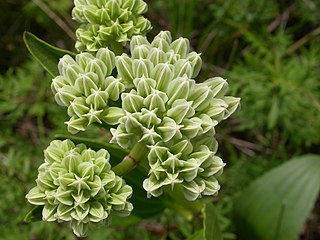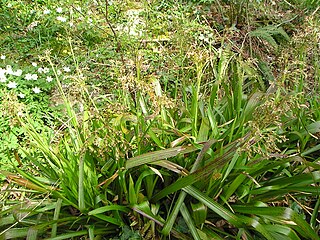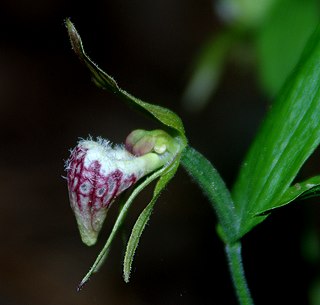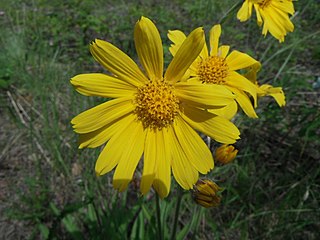
Butomus umbellatus is the Old World Palearctic and Asian plant species in the family Butomaceae. Common names include flowering rush or grass rush.

Juncaceae is a family of flowering plants, commonly known as the rush family. It consists of 8 genera and about 464 known species of slow-growing, rhizomatous, herbaceous monocotyledonous plants that may superficially resemble grasses and sedges. They often grow on infertile soils in a wide range of moisture conditions. The best-known and largest genus is Juncus. Most of the Juncus species grow exclusively in wetland habitats. A few rushes, such as Juncus bufonius are annuals, but most are perennials.

Juncus effusus, with the common names common rush or soft rush, is a perennial herbaceous flowering plant species in the rush family Juncaceae. In North America, the common name soft rush also refers to Juncus interior.

Arisaema triphyllum, the jack-in-the-pulpit, bog onion, brown dragon or Indian turnip, is a herbaceous perennial plant growing from a corm. It is a highly variable species typically growing 30–65 centimetres (12–26 in) in height with three-part leaves and flowers contained in a spadix that is covered by a hood. It is native to eastern North America, occurring in moist woodlands and thickets from Nova Scotia west to Minnesota, and south to southern Florida and Texas.

Heteranthera limosa is an annual flowering plant in the water hyacinth family known by the common names ducksalad and blue mudplantain. It grows in shallow water or on mud. It is considered a threatened species in parts of the central United States, and an invasive species weed in California, where it is a nuisance in rice paddies. It is also occasional in Florida waterways.

Juncus bufonius, known commonly as toad rush, is a widespread flowering plant species complex in the rush family Juncaceae.

Alisma gramineum is a small aquatic plant in the water-plantain family. It has several common names including narrowleaf water-plantain, ribbonleaf water-plantain or ribbon-leaved water-plantain, and grass-leaved water-plantain. It grows in mud or submerged in shallow fresh or brackish water in marshy areas.

Juncus acutus, the spiny rush, sharp rush or sharp-pointed rush, is a flowering plant in the monocot family Juncaceae.

Arnoglossum plantagineum also known as tuberous Indian-plantain, groovestem Indian plantain or Prairie Indian plantain, is a North American species of Arnoglossum in the sunflower family. he Latin specific epithet plantagineum refers to the leaves of the plant which are similar to those of a plantain.

Alopecurus aequalis is a common species of grass known as shortawn foxtail or orange foxtail. It is native to much of the temperate Northern Hemisphere from Eurasia to North America. It is most commonly found in areas near fresh water, such as the margins of ponds and ditches.

Luzula sylvatica, commonly known as greater wood-rush or great wood-rush, is a perennial flowering plant in the rush family Juncaceae.

Cypripedium arietinum, the ram's head lady's slipper, is a rare orchid that grows in lightly shaded areas with calcareous soils. It is characteristic of the alvars around the Great Lakes in North America, as well as in New England. In Canada, it is found from Quebec to Saskatchewan, plus an isolated population in Nova Scotia, where it grows on gypsum based soils, 330 km away from the nearest population in Maine.

Juncus acutiflorus, also called sharp-flowered rush, is a rush or a grassy plant of the genus Juncus. As the name suggests, the plant has notable sharp-looking flowers, flowering between July and September.

Oreojuncus trifidus is a species of rush known by the common names highland rush and three-leaved rush. It is native to the Northern Hemisphere, where it is an arctic/montane species with an amphi-atlantic distribution.

Arnica lonchophylla is a species of flowering plant in family Asteraceae. The common names for this species includes longleaf arnica, northern arnica, and spear-leaved arnica. It has daisy-like yellow flowers that are 2.5 to 5 cm across with a yellow center disks.

Juncus dichotomus is a monocot which belongs to the Juncaceae family of rushes. The plant is native in the Americas in temperate zones but has been introduced to other parts of the world. The species is often confused with other Juncus plants due to morphological similarity. Juncus dichotomus often is found in areas which prove to be very moist, and rainfall is a common occurrence. Juncus dichotomus is often most recognizable in the spring and summer months of the year due to its conspicuous flowers and infructescence.

Ephedra coryi, also known as Cory's joint-fir, is a rare, reed-like gymnosperm native to sandy, semi-arid areas of the North American South and Southwest.

Draba norvegica is a species of flowering plant in the mustard family (Brassicaceae) know by the common names Norwegian draba and Norwegian whitlow grass.

Isoetes melanopoda is a species of nonflowering vascular plant belonging to the quillworts in the family Isoetaceae. Its common names include: black-footed quillwort, midland quillwort, and prairie quillwort.

Carex muehlenbergii is a species of flowering plant, it is a type of sedge. It is a grass-like plant in the family Cyperaceae. Its common names include sand sedge, Muhlenberg's sedge.



















